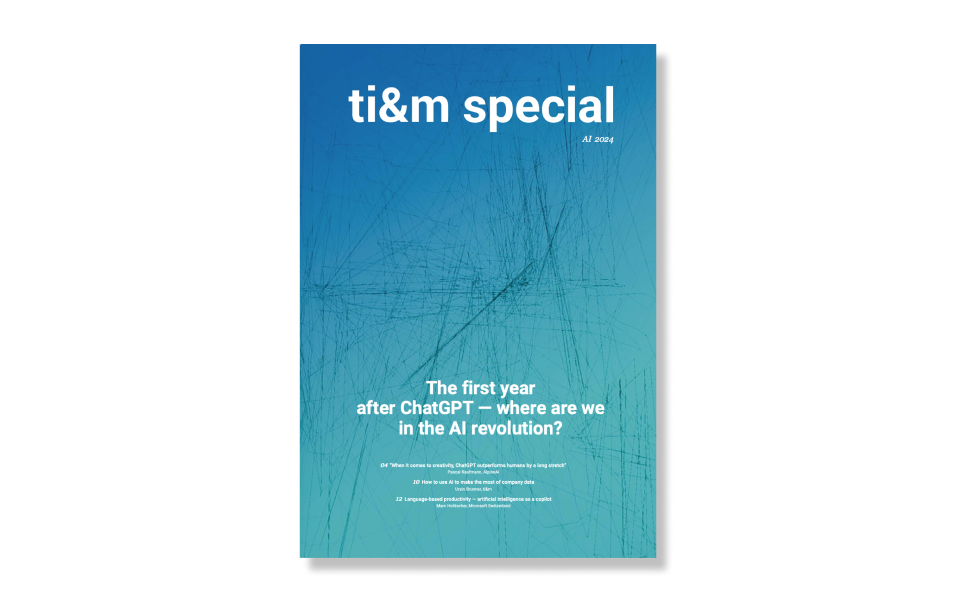The range of AI-generated creations has grown so much in a short time that the issue of whether it constitutes a creative process has become little more than a sideshow. Generative AI (GenAI for short) has cut right to the heart of the creative industry. The Hollywood writers’ strike shows how serious this is – regulatingAI forms a central part of the negotiations.
Who owns the property rights to works generated by AI?
For an AI system to generate texts and images, it must be trained using a huge amount of data. Data sets which are freely available on the internet are often used for this. Common Crawl is a good example. The platform is operated by a non-profit organization and has been collecting freely available online data since 2008. Today, Common Crawl’s dataset includes the content of 250 billion webpages. Every month, another 3 to 5 billion websites are added. Of course, this data also includes copyright-protected content. Viewing this from the input level of AI systems, we can also ask whether using this data infringes copyright, and who owns the property rights for the works generated by AI. Unlike in German copyright law, where text and data mining is explicitly regulated in Section 44b (UrhG) and, in principle, can be used for machine learning, there is no corresponding clause in Swiss copyright law. So at the input level we need to establish whether the use of training data amounts to unauthorized reproduction. Essentially, there is no current consensus on this among legal specialists. To be safe, you can use only data which isn’t protected by copyright, such as data published under an open source license, or make sure you have the copyright holder’s permission. We need to critically examine whether the training process and the temporary (and almost incidental) reproduction involved can be deemed reproduction in the sense of copyright. It may be that machine learning wasn’t what the legislator intended here. This seems more likely – especially since the work is not displayed during the training process, and the use of the work isn’t the objective of this training in itself. Some would certainly argue that we shouldn’t view the training process as reproduction in the legal sense, which would mean using published works for training purposes wouldn’t infringe copyright. However, we can assume that not all rights holders share this view. So it will soon fall to the courts and legislators to clear up the legal uncertainty surrounding this. In the US, Getty Images sued the AI company Stability AI, because its Stable Diffusion model created images with a clearly recognizable Getty Images watermark. Once logos appear in AI-generated images, this goes beyond copyright and raises issues relating to trademark and competition law. In Switzerland, regardless of whether training an AI system constitutes a reproduction of copyright-protected material, researchers at least can base their decisions on the academic limit (Wissenschaftsschranke) outlined in Article 24 d of the Swiss Copyright Law (URG). This allows data, and therefore text and data mining, to be used for research purposes but not commercial interests.
Human creativity is essential
The output level relates to the works generated by AI systems. In terms of copyright, the influence of human creativity plays a key role here. A camera is a good example to illustrate this in AI systems based on large language models. If the technology is used as a tool, like a camera, the person who uses the AI system can become the copyright holder of an AI generated work. This takes into account that the prompt – the instruction to the AI system – significantly influences the result. In a similar way to photography, a photorealistic AI image can incorporate the user’s specialist knowledge about the lens, lighting conditions, depth of focus and camera model into the prompt. This affects how the image is created. The order in which the terms are entered also plays a role here, while negative prompts can be used to prevent undesired effects. This means humans have a significant impact on the outcome and can be considered the originators of the work, as lawyer Matthias Städeli justifiably claimed in his presentation at the Conference on Computer Science and Law 2023. Even so, we haven’t yet heard the last word on the matter. Courts and legislators need to hone the legal position in relation to the output level as well. In Switzerland, we’re yet to see a court decision on matters of copyright and AI-generated works. However, on February 21, 2023, the US Copyright Office confirmed copyright protection for a graphic novel called Zarya of the Dawn. This novel was created using AI. The ruling did not grant protection to the images, which were created using the AI software Midjourney. It was the arrangement of the images and text elements, plus the text itself, that were eligible. These were all elements that were created by the artist, Kristina Kashtanova, and not by AI. Judgments of this kind show that it is possible to determine what is considered the artist’s creative influence.
Is software protected?
In an interview with Switzerland’s NZZ newspaper, Professor of Law Peter Georg Picht from the University of Zurich highlights a third factor: the system level. This is where we need a change of perspective. At the system level, we are protecting the AI system itself. Here, the software or code is protected by the copyright. The process on which the program is based is not. If AI systems are programmed with the same functionality but using a different code, this does not infringe the copyright. The newest developments in GenAI give rise to a lot of legal questions, not only in relation to copyright. Regulation is needed to prevent legal uncertainty. This could negatively impact trust in AI technology, with a knock-on effect on investment in this important research. In Switzerland, we’re resisting the temptation to create an all-encompassing AI law. This would inevitably fail given the rapid technological advancements. Instead, we’re concentrating on selected adjustments in the areas of law that AI affects. This allows us to create legal certainty and pave the way for Switzerland to be an attractive location for research and innovation.





